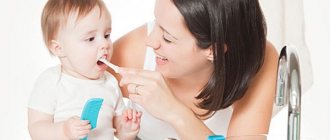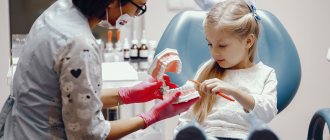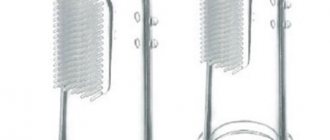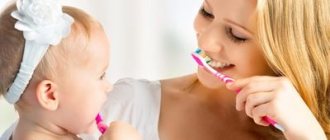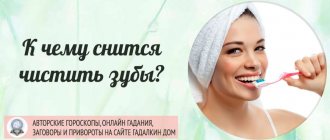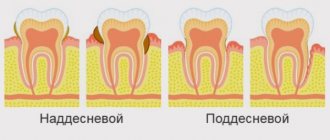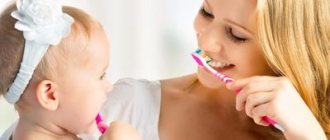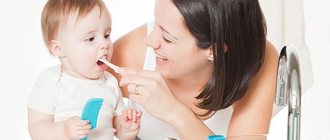It is important to keep baby teeth healthy, despite the fact that they are replaced by molars over time, because the latter depend on the quality of the former. Without proper cleaning, caries quickly develops on baby teeth, which can turn into permanent ones, sometimes even at the stage of their formation. In addition, early loss of baby teeth often causes permanent teeth to shift and cause problems with bite. To avoid these negative consequences, it is important to take care of your teeth from childhood, and in this article we will tell you how to teach your child to do this.
Teaching your baby to take care of his teeth
When should you start brushing your teeth?
From the moment the first tooth appears, which can erupt between the ages of five and eight months. Most often, the central incisors on the lower jaw appear first.
This is preceded by a period when the gums swell and bother the child. To alleviate the condition, you can give your baby a teething brush - it looks just like a regular one, but has thick and soft rubber bristles that massage the gums without injuring them. The baby will hold it himself, move it along the gums, bite the bristles to relieve itching, so he will quickly get used to the brush and the teeth cleaning procedure.
The teether has soft and thick bristles
When a child's first incisors appear, it is important to clean them with a children's toothbrush with rubber bristles. This procedure cannot be neglected, since at this age the baby eats liquid food, and only solid food (for example, raw carrots or apples) contributes to the process of self-cleaning of the oral cavity. Therefore, it is important to help the child get rid of plaque.
To begin with, let the baby touch the brush, examine it, and try to move it over the teeth himself. This will help him get used to the new subject. After this, you can begin the cleaning itself. It is important to brush your teeth correctly: move the brush from the gum to the edge of the tooth and do not forget about the inner surface.
Let your child try brushing his teeth so that he gets used to the procedure/figcaption>
In addition, the appearance of the first teeth is a reason to take the baby to the dentist. First, the doctor will evaluate the quality of the enamel and help prevent possible problems that may appear at an early age. Secondly, over time, such examinations will become something ordinary for the child and will not cause fear.
Give simple instructions
One of the success factors in teaching a child to brush their teeth correctly is a simple algorithm of actions. Think in advance about how to show your baby the whole procedure so that he understands what you are doing. And I was able to repeat it. Then show: very slowly, clearly performing every action and movement.
Act exaggeratedly slowly:
- take a toothbrush;
- apply cleaning agent;
- invite the child to repeat;
- brush your teeth;
- rinse your mouth and spit it out.
Remember that it is better to introduce any innovations in a calm environment and when the child is in a good mood. You should not teach him to brush his teeth when he is sleep deprived, irritated, or if you are in a hurry.
During cleaning, we stand facing the mirror, me behind. I read and say:
- Look, I’m brushing my back teeth. They are called chewable. And these are fangs. Let's clean the bacteria poop off them too. Oh, ready. And these are the incisors - your first teeth. And they were cleaned. You can take water into your mouth and spit it out.
You can consolidate your knowledge by reading in the evening before going to bed.
Illustration from the book “Masha and Misha. Brushing our teeth"
How to convince a child to brush his teeth?
If a child has not brushed his teeth since infancy, he will find the new procedure interesting the first or second time. And when he realizes that this is a daily activity, he may begin to “forget” or openly protest. In this case, we recommend proceeding as follows:
- Eliminating negativity.
If your child is angry or crying and doesn't want to brush his teeth, don't force him to comply at all costs. Don’t scare him with the words: “If you don’t brush your teeth, I’ll take you to the doctor.” This way he will become afraid of dentists. In addition, do not promise rewards: “If you brush your teeth, I’ll let you play some more before bed,” otherwise it will be difficult to refuse this scenario later.
Instead, allow him to express his emotions and don't scold him for them. Say: “I see you are upset/angry. You don’t feel like brushing your teeth.” When a person feels that he is understood, the degree of negativity decreases. You can give him a piece of paper and ask him to show how upset or angry he is. If your child, for example, crumples up paper or scribbles something furiously, say, “I understand that you are very angry.”
Do not scold your child for negative emotions, allow him to express them
- We brush our teeth together.
Show your child by personal example that brushing teeth is a daily procedure, obligatory even for parents. You can create a common ritual when dad, mom and baby brush their teeth together. This will allow the child to understand that he is in some way equal to his parents, since he has the same responsibilities.
Show him how to brush his teeth properly, and even if he is too slow at first, do not rush him and encourage him.
- We allow the child to show independence.
Let your child choose his own toothbrush and toothpaste. This will make him feel more independent. In addition, the process will be more interesting for the child if the brush or toothpaste packaging depicts favorite cartoon characters.
To prevent the procedure from being too short, buy an hourglass that measures two minutes and place it in the bathroom. This way your baby will be able to control the time himself.
The plaque indicator will give a rich color to poorly cleaned areas and motivate your child to brush their teeth more thoroughly.
- Discuss dental health with your children.
Offer cartoons and books about dental care and discuss what the child learned from them. Often there are stories told about heroes who did not brush their teeth, and as a result they got sick.
In addition, you can invite him to play dentist and buy a toy that needs to be used to fix his teeth. This will give your child information about why they need to take care of their mouth.
By playing out different situations, the child stops being afraid of doctors and understands the importance of dental care
Prepare your child
You can prepare your child for brushing his teeth in advance: initiate conversations and demonstrations, tell stories and read books. In moments of resistance or before going to the doctor, stories from books will help calm the baby and set him up for positivity.
Now my daughter is 3 years 2 months old. We have been using everything that I describe below since I was 1.4 years old. At first, I periodically asked: “Do you want me to tell you something about teeth?” If the daughter agreed, she said:
- We have teeth in our mouths. Let's knock them. Just imagine, we didn’t always have them. When you were born, you had no teeth and only drank milk. And then one erupted. This one (I show it in front of the mirror), and then this one. And look how many teeth have grown. Now you can bite an apple or chew a potato with them. This requires healthy teeth.
Do you know who lives on his teeth? Bacteria. They are so small that we cannot see them. They also eat apples and potatoes, which remain on your teeth. Bacteria do not harm us as long as there are few of them, they just eat. But then they start pooping (you could say they're excreting acid, but that would make less sense to my daughter). And their poop destroys our teeth.
Do you know what we do to wash away that poop and excess bacteria? We brush our teeth. Show me how we do it?
When the child agreed, I brushed my teeth and said: “That’s it, I washed away all the bacteria poop. Now my teeth will remain intact and healthy.”
If there were leftovers of food in her mouth, she would take it out and show: “Look how much food you took out. It’s good that we decided to brush our teeth.”
We also read books that touch on brushing teeth:
- "Exploring our body"
- "Connie at the Dentist"
- “Brushing teeth, making pee-pee”
- “Masha and Misha. Brushing our teeth"
How to choose a toothbrush?
The main thing when choosing is the material of the bristles: it should be synthetic, since natural materials do not dry well and microbes can accumulate in them. In addition, it should be soft or ultra-soft.
Children aged from one to two years need a brush with a head no more than 1.5 cm and a handle no longer than 10 cm. It is recommended to choose models with rubber or silicone inserts on the handle so that they do not slip out of the hands. From two to five years, a brush with a head length of 2 cm and a handle of 15 cm is suitable, and from five to seven years - 2.5 cm and 17 cm, respectively.
Children aged three years and older can use an electric toothbrush. Firstly, it will clean your teeth better. Secondly, often such brushes can be synchronized with a smartphone. This way, the child will be able to keep track of the procedure time and see on-screen tips on how to brush their teeth correctly.
It is necessary to change a regular brush or an electric brush head every two to three months, and also immediately after the child has had an infectious disease, such as a cold.
Measure the brushing time using an hourglass, so the child will understand how much time is left until the end of the procedure
Lead by example
Model the behavior you want to teach your child. Invite him into the bathroom with you during the procedure.
While brushing my teeth, I always asked my daughter: “Do you want to watch me brush my teeth?” If she agreed, she slowly showed me how I did it. At the end she added: “My breath smells so good. And the teeth are clean and strong. I can eat anything."
We recommend that you start brushing your teeth after the first baby teeth erupt and as soon as the child has learned to stand confidently. That is, after about a year:
- You have teeth now too. Do you want to clean them?
Introduce elements of the game into your routine, then you won’t have to insist and persuade. When the child gets older, you can organize small competitions:
-Who will reach the bathroom first? Who will be the first to pick up their brush?
How to choose baby toothpaste?
It is important to focus on the level of its abrasiveness. This indicator tells how much the composition erases tooth enamel when brushing, and is denoted by the abbreviation RDA. For children, a maximum of 20 RDA is acceptable, while for adults a level of 70 to 100 is safe.
In addition, baby toothpaste should not contain calcium carbonate and sodium bicarbonate, as these are harsh abrasives that can damage enamel. Instead, it is better to choose formulations with titanium or silicon dioxide.
Sodium lauryl sulfate, or SLS, is also toxic for children; it can dry out the mucous membranes and cause allergies. However, it is safe for adults. It is added to the paste to give it foaming properties. Accordingly, if the toothpaste produces abundant foam, this component is present in it.
To make it easier for your child to get used to the procedure, brush your teeth with him
The same reactions - dry mucous membranes and allergies - can be caused by parabens, which are used to preserve the composition and give it antiseptic properties.
Regarding fluoride content, the European Academy of Pediatric Dentistry (EAPD) recommends toothpastes with this component for everyone, including children after the eruption of their first tooth. Fluoride is necessary for the prevention of caries. In paste for children under four years old it should contain 200 ppm, children from four to eight years old need 500 ppm, and after eight years old - 1450 ppm.
In addition, fluoride has an alternative - synthetic hydroxyapatite, which is identical to natural hydroxyapatite, which makes up tooth enamel. This substance is easily integrated into the crystal lattice and strengthens it, sealing all microcracks, reduces sensitivity and prevents the development of caries. The only disadvantage of pastes with hydroxyapatite is that they are more expensive than fluoride ones.
The sooner you start paying attention to your child’s oral cavity, the faster and easier he will learn to take care of his teeth. If the baby was not taught to brush his teeth while he was very young, everything can be corrected. The main thing is to be patient and act consistently, then over time the procedure will become a familiar ritual for him
Create conditions for brushing teeth
It is much more effective to take a course not on “teaching”, but on “helping to master” oral hygiene. Create conditions under which the child can repeat your behavior. Organize convenient independent access to a sink, personal toothbrush and toothpaste, taking into account age, height and capabilities.
Choose the right children's toothbrush, taking into account the fact that the child will brush his teeth himself. This means that it should be comfortable for the baby's hands and mouth.
To choose a good toothpaste, consult a specialist. Doctors recommend the appropriate option depending on several factors:
- fluorine content in water;
- heredity and dental conditions;
- child's preferences.
When kids eat pasta for the taste, try replacing it with salted pasta. But you need to take a closer look. A child may eat toothpaste because of the process of eating from the tube. Then it’s worth offering fruit spiders and “space” food.
The tube provokes squeezing, because this is a very exciting activity. This will make it difficult to control your toothpaste consumption. You can use a small container and allocate a small amount of paste for a couple of cleanings.
At first I got confused and found a microtube of toothpaste from the hotel. I cut off a wide part, washed it, inserted the desired paste, put the wire in and twisted it. I didn’t think of a jar then, but my daughter learned how to squeeze out the paste.
And I always said “thank you” when she squeezed out a little. This was almost always the case. Then we switched to a large tube. A lot is squeezed out of it only when the empty tube is replaced with a full one.
A special glass for rinsing your mouth is also useful. Let your baby draw the water himself and place the glass on the surface next to him. This way, independence will become an important part of the entire learning process. This means that the child will be more willing to participate in the process.
Don't forget about the mirror, children love to watch their actions.
Be consistent
You need to brush your teeth regularly. Perhaps the only case when it is inappropriate to remind a child of this need is if he is sick and falls asleep earlier than usual. Your and his fatigue, bad mood, urgent work - all this is not a reason to ignore basic hygiene procedures.
And a life hack for absolutely any conflict with a child: parents must adhere to a common point of view on the problem. There should be no division into “brushes and apples”; refrain from public disputes. If adults do not agree with each other, what can be expected from the child?
Instill in your child a love for their teeth
Doing something because you have to is sometimes very difficult. Developing a mechanical habit in a child is a dubious pleasure. But you will never lose if you convince your child that his healthy smile is the best decoration. Ask to show your teeth and announce with a smile: “Beautiful!” Wonderful white teeth! So well-groomed, clean and shiny!” Perhaps, in principle, it’s difficult for you to give compliments - fight with yourself, learn. Find kind words, even if your teeth are far from ideal. 5-10 encouraging words will cost you much less than a dentist. Allow yourself to frown sometimes: “Why are your teeth so yellow? Didn’t you clean it?”
Personal example
Trying to teach a child to do something that you don’t do yourself is a completely useless exercise. Brush your teeth twice a day and invite your child with you - kids love to imitate adults. At the same time, stop saying phrases like these: “He has my teeth, bad ones. By the age of 50, you still have to change everything. To hell with them, I’ll get implants later. There are only problems with these teeth, you need to pull them out and not suffer.” Even good teeth can be ruined by mediocre care, and treating problem teeth carelessly is a crime against yourself.
At what age should a baby's teeth be brushed?
Dentists agree that caring for baby teeth should begin from the very beginning of their appearance. For most babies, teething begins between 6 and 8 months. Only some babies give their parents their first tooth a couple of months earlier.
During complementary feeding, the baby’s first erupted tooth is “attacked” by carbohydrates, which are deposited on the enamel in the form of plaque.
It must be removed to avoid the accumulation of soft deposits with bacteria. You should start caring for your new tooth from the moment it completely erupts. Important!
Until the baby tooth has fully emerged from the gum, excessive care can be harmful - the inflamed area of the gum is very vulnerable and touching it will be quite painful for the baby.
Dental care plan
To reinforce the effect, parents can create and print a colorful plan for brushing their teeth.
Then you need to hang it in the bathroom at the child's eye level .
This way, the child will not forget about the important stages of cleansing and will begin the task with interest.
The following items should be included in the plan::
- Rinse your mouth thoroughly with warm water from a glass.
- Squeeze a pea-sized amount of paste onto your toothbrush.
- First brush the upper teeth, then the lower ones.
- Connect the upper teeth to the lower teeth and brush in a circular motion on the outer right side.
- Now - the outer side on the left.
- Open your mouth and thoroughly clean each tooth from the inside.
- Stick out your tongue and brush it with the back of the toothbrush head.
- Rinse your mouth.
- Rinse the brush so that no paste remains on it and place it in a clean glass with the head facing up.
